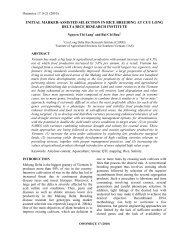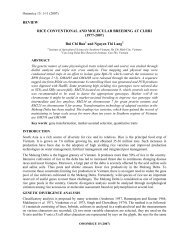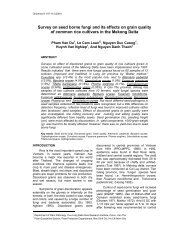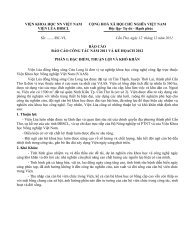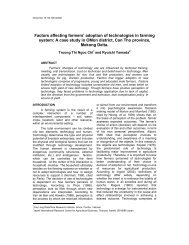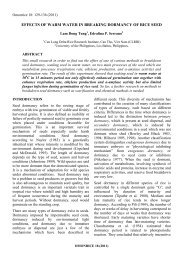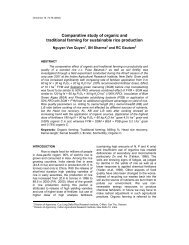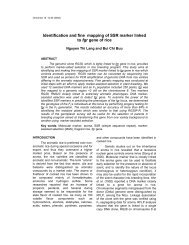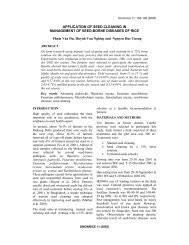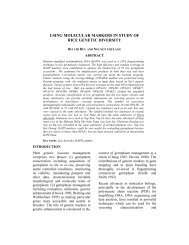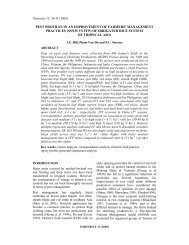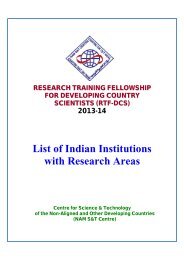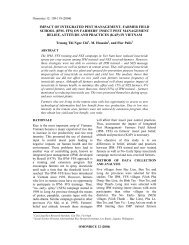BIOCONVERSION OF PADDY STRAW AND BIOFERTILIZER FOR ...
BIOCONVERSION OF PADDY STRAW AND BIOFERTILIZER FOR ...
BIOCONVERSION OF PADDY STRAW AND BIOFERTILIZER FOR ...
You also want an ePaper? Increase the reach of your titles
YUMPU automatically turns print PDFs into web optimized ePapers that Google loves.
60<br />
Tran Thi Ngoc Son et al.<br />
Biofertlizers<br />
4 Fungal inoculants (Trichoderma sp.) in<br />
powder formula produced by CLRRI’s<br />
Soil Microbiology Department was<br />
applied to treat rice straw for<br />
decomposition as organic manure.<br />
5 Bioferilizers for nitrogen fixation on rice,<br />
soybean and groundnut<br />
(Gluconacetobacter diazotrophicus,<br />
Bradyrhizobium<br />
japonicum/Bradyrhizobium sp.) that<br />
produced by CLRRI’s Soil Microbiology<br />
Department and Biotechnology Research<br />
and Development Institute (BRDI), Can<br />
Tho University.<br />
6 Bioferilizers for phosphate solubilizing<br />
bacteria on soybean and groundnut<br />
cultivation (Pseudomonas syringae) that<br />
produced by BRDI, Can Tho University.<br />
Methods of inoculant production:<br />
Fungal inoculant (Trichoderma sp.) in powder<br />
formula was applied to treat into rice straw heap<br />
with adequate moisture supplying for<br />
decomposition. It took around 21 - 24 days after<br />
inoculation (2 kg/ton of rice straw); decomposed<br />
rice straw was used as organic manure<br />
Bradyrhizobium japonicum (USDA 110 strain)<br />
for soybean and Bradyrhizobium spp. (NC92<br />
strain) for groundnut are grown in the G6 medium<br />
(Singleton et al, 2002), in 4 days on rotary shaker<br />
and population reaches >10 9 cells/ml, rhizobial<br />
liquid was mixed with sterile peat at 50%<br />
moisture. Rhizobial inoculant (>10 9 cells/g) was<br />
contained in plastic bags and stored at room<br />
temperature.<br />
Pseudomonas syringae (P18 strain) was isolated<br />
from soybean rhizosphere soil and was<br />
determined high soluble phosphate and IAA. It<br />
was grown in sucrose apatite medium (Whitelaw<br />
et al, 1999) in 7 – 10 days and population reaches<br />
>10 9 cells/ml, pseudomonad liquid was mixed<br />
with the combination of sterile peat and bagasse at<br />
50% moisture and the inoculant (>10 9 cells/g) was<br />
put in plastic bags and stored at room temperature<br />
The Gluconacetobacter diazotrophicus strains<br />
isolated from roots and stems of sugar cane and<br />
determined high level of fixed nitrogen. They are<br />
grown in 10% sugar medium (Cavalcante and<br />
Dobereiner, 1988) in 4 days on rotary shaker and<br />
population reaches >10 9 cells/ml. Bacterial liquid<br />
was mixed with the mixture of sterile peat and<br />
bagasse at 50% moisture and contained in plastic<br />
bags and stored at room temperature (>10 9<br />
cells/g)<br />
Experimental demonstration model layout<br />
Field demonstrations were conducted in alluvial<br />
soil, unfertile sandy soil and lightly acidic soil<br />
conditions with the rotational system (Rice –<br />
Legume – Rice). The model experiment was<br />
arranged in two treatments<br />
* For rice cropping<br />
1 Recommended model: 6 ton composted<br />
paddy straw by Trichoderma sp. fungus +<br />
25 kg N+ 200 kg bio-fertilizers (100 kg/ha<br />
bio-phosphate fertilizer [Pseudomonas<br />
syringae] and 100 kg/ha nitrogen fixing<br />
bacteria inoculant [Gluconacetobacter<br />
diazotrophicus]) + 30 K 2 O kg/ha<br />
2 Farmers’ practices model: the fertilizer<br />
doses applied as farmers’ practices<br />
* For upland cropping<br />
The demonstration model was continued in<br />
Spring-Summer 2007 in the same 30 farmers’<br />
fields that practiced of previous rice crops. At An<br />
Giang and Can Tho provinces soybean were sown<br />
and at Long An provinces was groundnut crop<br />
after rice. The model experiment was laid out in<br />
two treatments viz. recommended practice (RP)<br />
and farmers’ practice (FP) as following:<br />
1. Recommended model: 20 kg N + 2 liters /ha<br />
bio-phosphate fertilizer [Pseudomonas<br />
syringae] + 2 liters /ha nitrogen fixing<br />
bacteria inoculant [Bradyrhizobium<br />
japonicum inoculants for soybean /<br />
Bradyrhizobium spp. inoculants for<br />
groundnut] + 30 K 2 O kg/ha<br />
2. Farmers’ practices model: the fertilizer doses<br />
applied as farmers’ practices<br />
3. Model area: 1,000 m 2 . Each kind of model<br />
was replicated for 10 times representated as<br />
OMONRICE 16 (2008)



